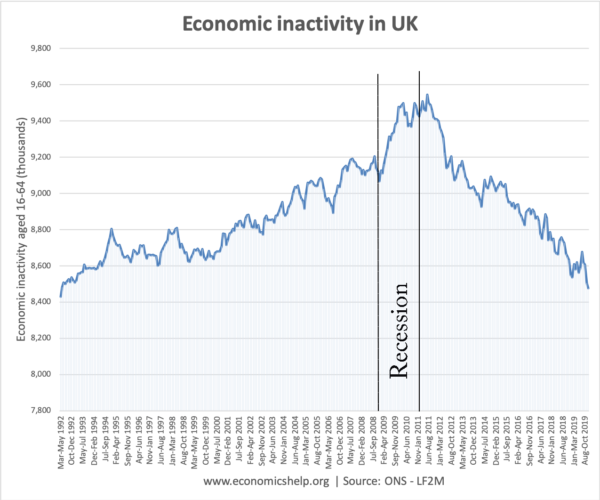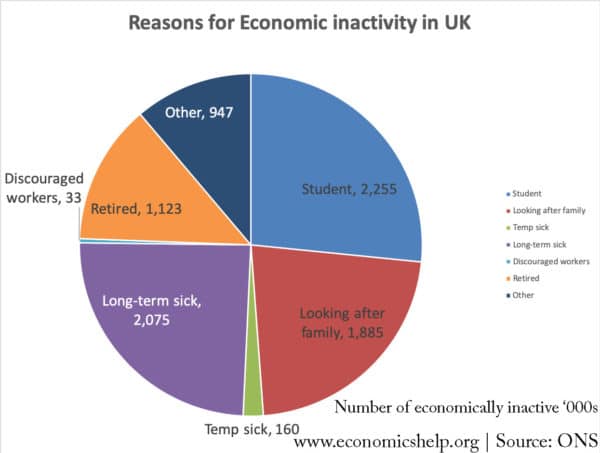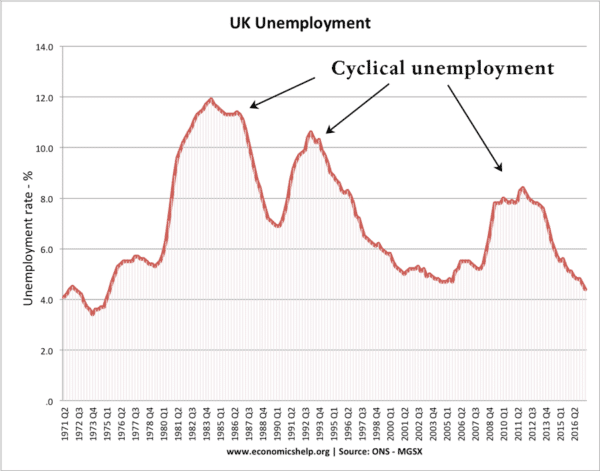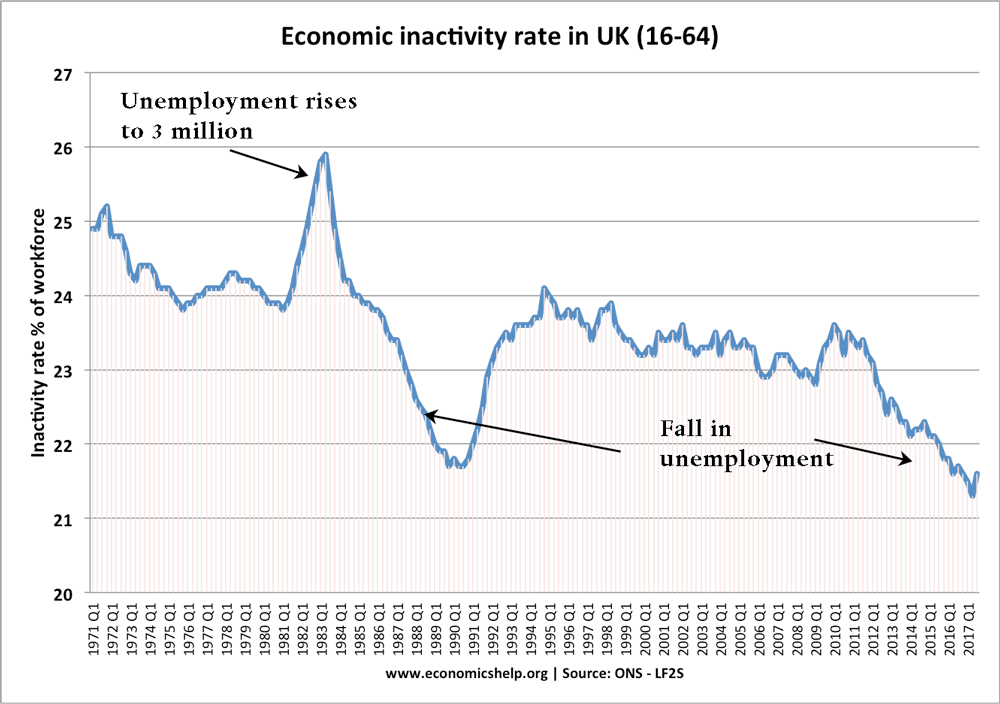Definition: Economic inactivity means that people (aged 16-64) are not involved in the labour market – they are neither working or actively seeking employment. Economic inactivity includes students, early retirees and the long-term sick. There are 8.5 million counted as economically inactive in the UK.
- The unemployed who are seeking working and willing and able to accept a job are counted as economically active.
- Economic inactivity is related to the participation rate (% of the population economically active). A rise in inactivity means a fall in the participation rate.
Reasons for economic inactivity
Source: ONS
- Early retirement. People who are made redundant may choose to take early retirement and live off savings rather than re-enter the labour market.
- Student. A high school student, university student or someone on a full-time training course is counted as economically inactive.
- Looking after family/home. People who stay at home to care for members of the family are counted as economically inactive as they do not have time to work in paid employment. This can also include people who stay at home to look after the children and the house.
- Discouraged workers. After several years of seeking employment, the long-term unemployed may give up and leave the workforce. This may involve moving on to sickness benefits or acting as a caregiver/parent.
- Long-term sickness/disability. Another cause of inactivity is those who are physically unfit to enter the labour market and gain full-time employment.
- Other. This could include people who choose alternative lifestyles, for example being self-sufficient and growing your own food. As there is no official job, it would count as economically inactive.
Economically inactive and wanting to work
The UK produces statistics on rates of economic inactivity. This includes a category for those who want a job and those who do not want a job. For example in Oct-Dec 2019. There were 8.5 million people aged 16-64 who were classified as economically inactive. Of these
- 6,605,000 did not want a job
- 1,873,000 did want a job
The distinction is that within economic inactivity – somebody may want a job – but they are not in a position to actually take one. For example, if you are staying at home to look after an elderly parent, you may want a job. However, if you are unable to take any job offered, you are not counted as unemployed. To be counted as officially unemployed, you have to be willing and able to accept a job.
Alternatively, people with long-term sickness may want to work but be unable.
Trends in economic activity
 Source: ONS
Source: ONS
This shows there is a cyclical element to economic inactivity. In a period of rising unemployment, we tend to get a rise in economic inactivity. Why is this?
- When unemployment rises and there are fewer job prospects; there will be a rise in redundancy so it is more likely older workers may choose to take early retirement than struggle in a difficult labour market.
- In a period of unemployment young people have a greater incentive to study and be a student rather than enter a difficult labour market.
- If wages are lower, work may be less attractive and it is cheaper to have one parent look after their children rather than employ childcare provision.
Economic inactivity since 1971
Could the economically inactive fill job vacancies?
In Feb 2020, the UK government announced new immigration laws which restrict the number of ‘unskilled’ workers from the EU. The home secretary Priti Patel announced that the economically inactive could fill these vacancies. How realistic is that?
- Early retirees – it is difficult to persuade early-retirees back into the labour force. They tend to have more economic independence and would need a well-paid job with interesting activities. They are very unlikely to want to take on relatively low paid ‘unskilled’ work.
- Students. Students already take on part-time work to help finance study. But, it would be difficult to significantly change this. Especially since in the new immigration climate, the government are encouraging firms to train more native-born workers – this may require more students not less.
- Care-givers. One opportunity to reduce economic inactivity would be to provide greater social care for those needing long-term treatment. This would free-up current care-givers to take on paid employment. However, this kind of social care would be very expensive and it is difficult to see how the government would be willing to make any significant change in freeing up long-term care-givers. It may also require immigrants to work as care-givers.
- Discouraged workers. There is scope amongst discouraged workers to increase labour market participation, but the number in this category is very low – only 33,000 in Dec 2019.
- Long-term sick. This is one of the biggest categories at 2.07 million. Within this category, there is a range of different sub-categories. Some may be able to work – at least in non-manual work or part-time. However, it is already a contentious issue with Universal Credit being blamed on forcing genuinely sick people to take jobs they can’t really do or lose benefits.
Conclusion
With 8.5 million economically inactive, it is a very significant part of the population. However, ‘economically inactive’ is a rather misleading term.
- Students are increasing long-term labour productivity.
- Care-givers are offering a vital public service – which would have a very high cost should the government pay directly.
- Parents and people who look after family also provide a hidden economic service.
- Early retirement is chosen by many who want to prioritise leisure over monetary gain.
- The long-term sickness of 2 million suggests we should endeavour to try and improve the health of the population – through better preventative policies for issues like diabetes and heart disease.
Related



